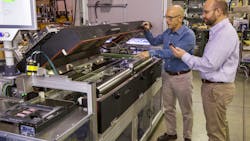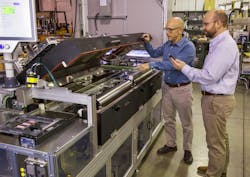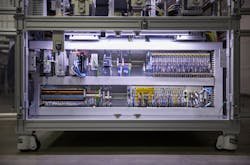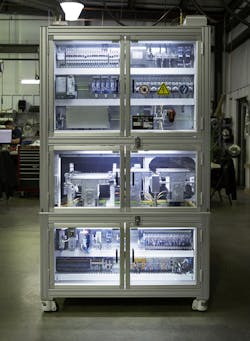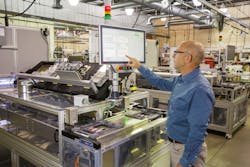Redesigned Testing Machine Set Up to Gather and Use Big Data
When a tier-one automotive supplier, a long-time customer of Pensar Otra Vez
More than 20 Pensar-built handlers were already working at one of the customer’s Texas plants, so there was a clear baseline to measure improvements against.
The handlers receive incoming PCBs at room temperature, elevate them to approximately 110°C and hold that temperature within ±3° during a test that simulates operating conditions in a vehicle. The test takes less than 120 sec., so the handler must quickly heat the PCB. The PCB goes through four preheat stops while IR sensors monitor temperature rise. On the previous generation of handlers, this created a wiring challenge with significant costs for labor and cables. Throughput is most important, so the handler must also maximize testing, not handling time.
The goal of the redesign was to increase performance and lower component costs as the handler followed the same testing processes. In addition, the company wanted to update the HMIs for easier operation and maintenance. Finally, the user wanted the handlers to have better data acquisition and analytics capabilities as a path toward IIoT and Industry 4.0. This automotive vendor has plants around the world with plans for widely measuring processes and enhancing efficiencies.
Pensar had a few other goals in mind as well. They wanted the machine to use less cabling, be smaller and be easier to use.
“Energy management in this customer’s factories is growing more and more important. This includes everything from automatically powering down conveyors when not in use to accurately monitoring motor rpm,” Edwards says. “The client already uses sophisticated data acquisition at the host level to monitor and predict machine performance. But older equipment uses components from several vendors to independently control zone temperatures and operate temperature loops. Collecting more data, if available and possible with the previous design, was a programming challenge since a clean path was not always available for communication among devices.”
Although the client previously handled machine programming, Pensar took up the task this time. The original machine logic was created in Visual Basic to run on a PC, but the auto manufacturer wanted more flexibility and access to performance data across the system. Pensar worked with D2 Engineering LLC
“One of the main goals for the software was to provide access to all systems and devices through a single development environment,” explains Dan Distefano of D2 Engineering. “Based on my 20-plus years of experience with Beckhoff equipment, it was clear that TwinCAT 3 automation software and EtherCAT industrial Ethernet were the best fit, and they work well with third-party components.”
Using TwinCAT 3 as the universal engineering and runtime software simplified design and commissioning of the new handler’s controls. TwinCAT 3 also let users program in computer science standards and all IEC 61131-3 languages with object-oriented extensions. The team used several TwinCAT packages including its HMI for the operator GUI, the PLC and Motion for machine control and TwinSAFE for a safety subsystem.
The TwinCAT program is loaded on a C6030 ultra-compact industrial PC from Beckhoff that boasts a seventh-generation Intel Core i3 processor with two cores and a 3.9-GHz clock speed. To improve the operator interface, the handler features a CP3921 multi-touch control panel with custom push-button extension, and a 21.5-in. (1,920 × 1,080) display. “Not only are the new Beckhoff touchscreen displays enclosed in very sleek aluminum enclosures,” says Edwards, “we can also add the e-stop and other switches in the bezel below the touchscreen. This simplifies wiring, and it groups essential operator inputs in a way that makes sense.”
EtherCAT improves communication and motion control by connecting all key machines into one network. It does not use IP addresses for network devices; instead, it automatically identifies and configures each device on the network using Automation Device Specification (ADS), a device- and fieldbus-independent interface built into TwinCAT. “As a result, each device can be accessed, commissioned and debugged without using more software,” says Distefano.
The choice of network topologies, using one-cable automation (OCA) via the EtherCAT P standard, and eliminating switches all helped shrink the machine’s footprint and complexity of its wiring. The handler uses a mix of IP20-rated I/O terminals, IP67-rated box modules and OCA devices to provide communication and power for field devices in a single cable.
“EtherCAT P and machine-mounted I/O components let us run just a single cable back to the main control cabinet,” notes Edwards. “In addition, using Beckhoff components in the control panel eliminated even more wiring and basic terminal blocks, and reduced panel space needs and wiring time to sensors and motion control components in the field.”
To carry the PCBs through the test stations, the handler operates a conveyor powered by IP54-rated AS2022 stepper motors with torsion-proof encoders built in, paired with AG2250 7-to-1 gearboxes. DIN rail-mounted EL7047 stepper-motor terminals power the two-phase stepper motors, delivering 8 to 48 V dc at 5 A via a one-cable connection.
The previous design used a motor and gearbox on each side of an edge-belt conveyor. The motor speed was displayed as a numerical analog number that wasn’t motor rpm or belt fpm. The new Beckhoff drive easily displays true motor rpm, so both conveyor sides can be accurately monitored and adjusted. This also provides greater control and data acquisition compared to the previous machine design
The redesigned handler cost 9% less than the previous versions, it used 11% less labor to wire it and the electrical cabinet is almost 13% smaller due to fewer number of terminal blocks needed. The overall system was also easier to debug; the team knocked 36 hours off the design time for the controls.
The redesigned handler has been operating in the field without issue, and the Pensar Otra Vez team would like to retrofit the others with the new architecture eventually.
James Figy is a senior content specialist for Beckhoff Automation LLC.
